 This article was originally published a few years ago at the RockStar Success Library. It has great tools for connecting with other people!
This article was originally published a few years ago at the RockStar Success Library. It has great tools for connecting with other people!
Nicholas Boothman’s book has a title that sounds like a infomercial at 2 in the morning. When you get past that it’s a solid piece of work. It examines the critical first moments of a new relationship, i.e., how to build rapport with someone. I often train groups on communication skills, and the first thing we talk about is building rapport. As I see it, rapport is the bridge that allows communication to flow between two people.
How to Make People Like You in 90 Seconds or Less is powerful for two reasons. The first is because it is tool based – it actually helps you develop the skills that it discusses. The second reason is that it focuses on the front-end of the relationship – that critical bridge-building that most communication books gloss over. This isn’t so much a book on creating strong friendships or business ties as it is about creating the foundations for those relationships.
Big Thought
Your ability to connect with others influences the quality of your life. And your abilities can be improved through conscious effort to find the commonalities you have with others.
Ideas, Implications, and Questions
- Nicholas does a great job of connecting your inner attitude to your external demeanor. He calls it a Really Useful Attitude. “In face-to-face situations, your attitude precedes you. It is the central force in your life – it controls the quality and appearance of everything you do” (pg. 41). I’ve also found that one of the biggest differentiators between good and bad communicators is simply their attitude; the way they approach life and the people in it.
- Probably the most important idea I took away from the book was that people like people like themselves. Nicholas points out that the key to establishing rapport with strangers is to learn how to become like them (pg 31). Probably one of the biggest challenges for people in learning to connect with others is finding how to become like them while still maintaining their own authenticity. It’s not always an easy line to walk, but it’s worth trying. I think that, when in doubt, always err on the side of your personal authenticity – the most important relationship you have is the one with yourself.
- There’s a masterful treatment of how different people can favor one of three different senses: visual, auditory, or kinesthetic. Learning which paradigm someone prefers can allow you to connect with how they think much more easily. For example, I know I am very visually-oriented. If you want me to really “get” something, describe it to me in pictures.
- The biggest challenge I have with this book, or any book on communication, is that there is an implicit feeling that someone has to be hyper-aware when speaking with someone to effectively use all of the tools and be a good communicator. This often turns people off from learning these skills. Don’t get stressed, it takes time to integrate these into habits.
Should you read this book?
I think this is a great place to start for anyone who wants to develop their communication skills. I think it’s especially important for anyone who regularly meets new people, for example, a business person who attends networking events or meets a lot of new clients. It’s written in a style that’s easy to digest and the tools can be a lot of fun to practice.
